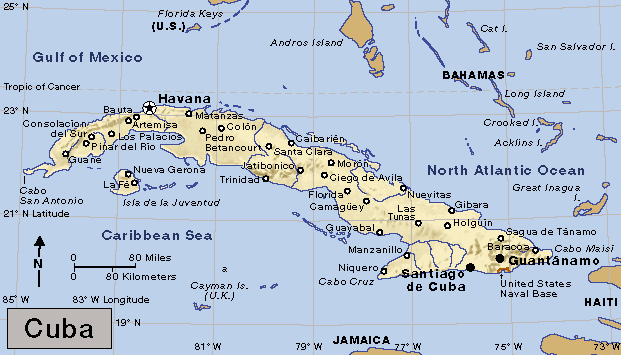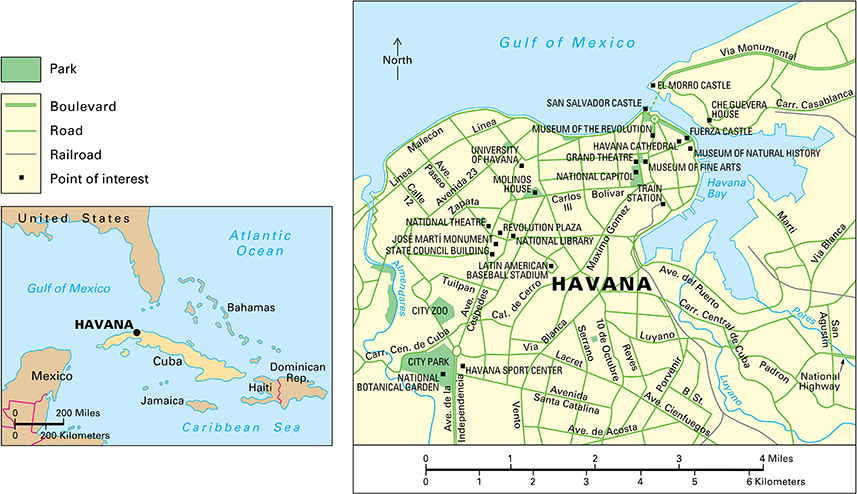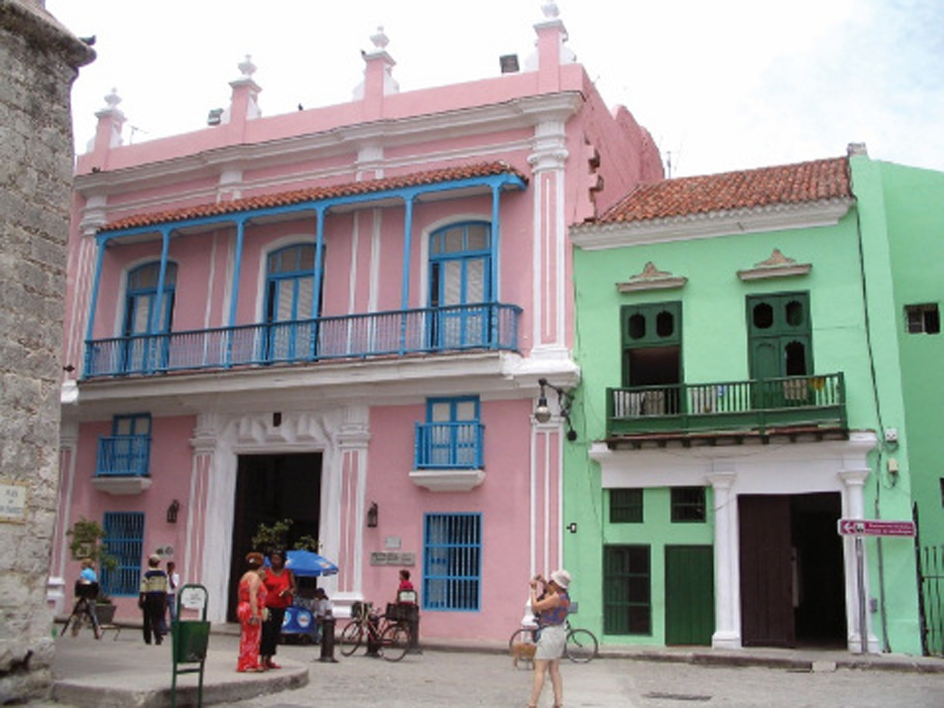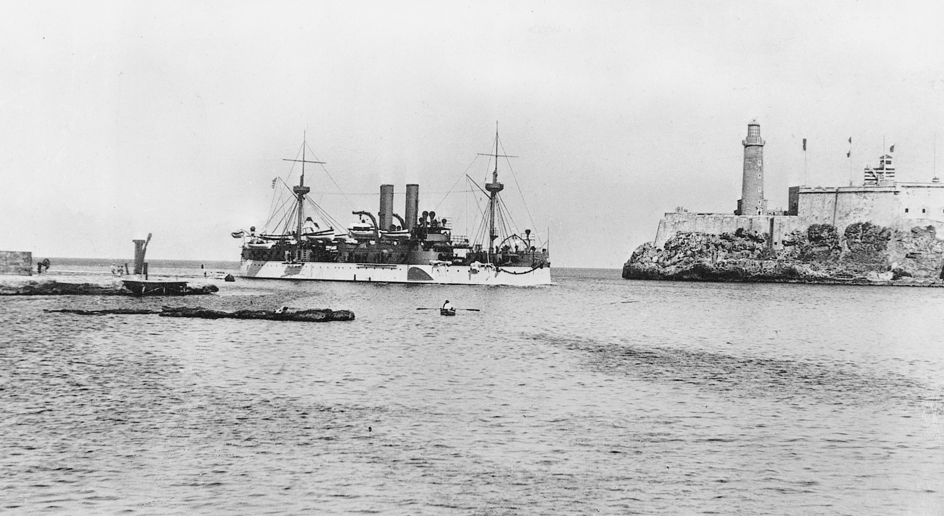Havana << huh VAN uh >> (pop. 2,106,146) is the capital, chief port, and largest city of Cuba. It lies on the island’s northwest coast, about 100 miles (160 kilometers) south of Key West, Florida. Spanish colonists built Havana near a large natural harbor in the 1500’s. The city’s name in Spanish, the language of Cuba, is La Habana. 
The city
of Havana covers about 286 square miles (740 square kilometers). Several historic forts, including El Morro Castle, stand along the entrance channel to Havana Bay. They were built from the 1500’s through the 1700’s to guard the bay. 
Old Havana, the colonial part of the city, lies west of Havana Bay. Tile-roofed houses dating from the 1500’s to the 1800’s line the narrow streets. This historic area also includes Havana Cathedral, built in the early 1700’s, and the Spanish governor’s palace. 
The National Capitol building—the seat of Cuba’s National Assembly of People’s Power—and many other government buildings are in downtown Havana, west of the old city. Newer residential areas and suburbs lie west of downtown Havana. The Malecón, a boulevard constructed by the United States military from 1898 to 1902, runs along Havana’s waterfront. It connects the western residential areas with downtown Havana.
Education and cultural life.
All schools in Havana and the rest of Cuba are public schools, and education is free. Many adults attend night school and job-training classes. The University of Havana, founded in 1728, is Cuba’s oldest and largest institution of higher education.
Havana’s cultural attractions include the National Symphony Orchestra of Cuba and the internationally acclaimed, state-run National Ballet of Cuba. The Museum of Fine Arts features classical and modern art. The Museum of the Revolution and the Museum of the City are prominent historical museums.
Economy.
Havana is the commercial and industrial center of Cuba. The government controls or regulates all industries. Health care is an important service industry in Havana. Most of the city’s workers are employed by government entities. Since the 1990’s, a growing number of people have operated small private businesses.
Havana’s oldest manufacturing activity is the processing of tobacco. Other industries produce beer, chemicals, food products, shoes, and textiles. Many of Cuba’s imports and exports pass through Havana.
An international airport serves Havana. Buses and taxis provide most of the transportation within the city.
Government.
Havana makes up a province of Cuba. A governor and provincial council head Havana’s government. For purposes of local government, Havana is divided into municipalities, each with an elected assembly. Delegates from municipal assemblies elect the governor. The provincial council includes municipal assembly leaders and municipal mayors. See Cuba (Provincial and local government).
History.
Diego Velázquez de Cuéllar, the first Spanish governor of Cuba, founded Havana on the island’s south coast in 1515. But the city failed to flourish, probably because of pirate attacks and unhealthy conditions, and was rebuilt on its present site in 1519. Havana’s location and harbor soon made it a gathering place for convoys of merchant ships carrying treasure from the Americas to Spain. Havana was made the capital of the colony of Cuba in 1552, and then became an important commercial center in Spain’s empire. By 1600, 4,000 people lived in Havana.
British troops captured the city in 1762 and held it for nearly a year. The British occupation stimulated trade between Havana and the British colonies in North America. The increased trade helped Havana’s population surpass 50,000 by the late 1700’s.
Cuba remained a Spanish colony through the 1800’s. In 1895, Cuban separatists launched a war for independence. In 1898, the United States sent the battleship Maine to Havana to protect Americans in Cuba. After the ship exploded mysteriously, the United States declared war on Spain, triggering the Spanish-American War. Spain lost the war, and in 1899 Havana became the seat of a U.S. military government in Cuba. Cuba was granted independence in 1902, and Havana became the new republic’s capital. See Cuba (Struggle against Spain). 
During the first half of the 1900’s, the Cuban government spent much money to make Havana a resort center. American companies invested heavily in Havana businesses. Thousands of visitors from the United States and other countries poured into the city. But despite Havana’s prosperity, many of its people lived in poverty. Tourism from the United States virtually disappeared after Fidel Castro took over Cuba in 1959 and then made it a Communist country. The United States soon broke diplomatic relations with Cuba and imposed economic sanctions on the country.
In the 1960’s and 1970’s, the Cuban government invested more in the nation’s rural areas than in its large cities. As a result, Havana experienced some serious problems, including a shortage of housing. The government took over many hotels and the mansions of people who left Cuba and converted them to public housing. The government also built new housing, hospitals, and office buildings. However, Havana’s housing shortage worsened in the 1990’s as a result of migration to the city from other parts of Cuba.
Beginning in the 1990’s, an increase in tourism from Canada and Europe benefited Havana. In addition, an increase in government investment in Havana beginning in the late 2010’s reinvigorated the city.
